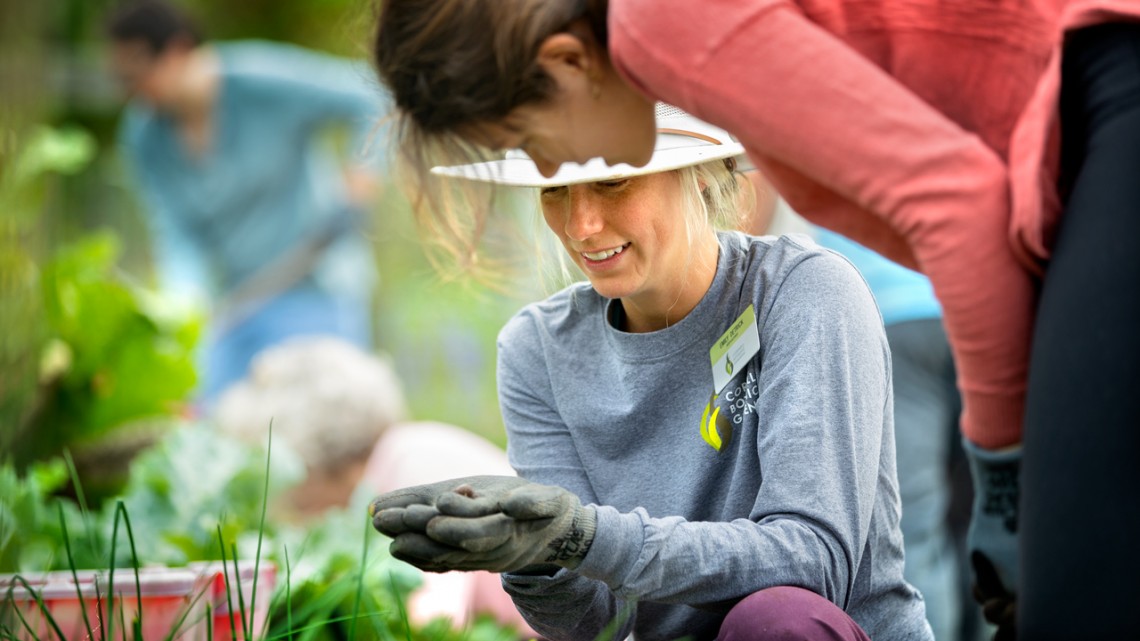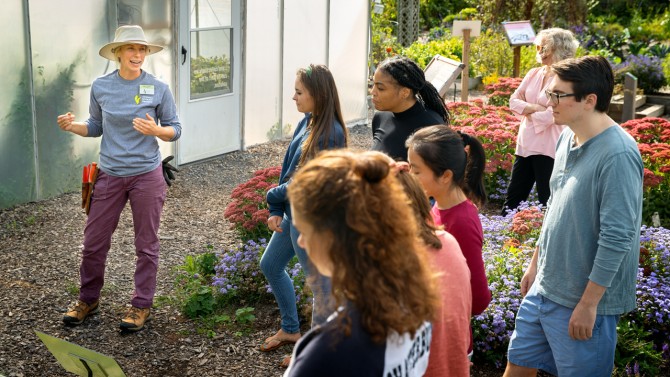
Emily Detrick, a horticulturist at the Cornell Botanic Gardens, uses the Pounder Vegetable Garden to teach students in Marcia Eames-Sheavly's Seed to Supper class.
Botanic Gardens staffer connects people and plants
By Nancy Doolittle
With a background in fine arts and experience working in museums and galleries, Emily Detrick, M.P.S. ’16, has always been interested in curation – the documentation and care of collections.
Now a horticulturist at the Cornell Botanic Gardens, Detrick continues to curate collections. But now those collections are beds of live plants, and she spends her days connecting people with them.
“A botanic garden is a museum full of living collections,” Detrick says. “By definition, botanic gardens are public-facing in their orientation, providing a gateway to the natural world, helping people to understand what’s all around them and the importance of plants in our lives.”
Citing the Botanic Gardens’ new mission, Detrick said her role is to inspire people – through cultivation, conservation and education – to “understand, appreciate and nurture plants and the cultures they sustain.”
She maintains and develops the Pounder Vegetable Garden and the Shady Ground Cover Collection; coordinates volunteers for the Heasley Rock Garden; leads tours; and teaches undergraduates. This semester, Detrick is drawing from her artistic sensibilities by teaching Cornell’s Art of Horticulture, a class developed and taught for many years by Marcia Eames-Sheavly, senior lecturer and senior extension associate in horticulture. Detrick also recently led a session on community gardening for Eames-Sheavly’s Seeds to Supper class.
Detrick loves the diversity of work that comes with the four seasons, the variety of plants that make up display gardens, and the connections to many other interests in food, medicine, fiber, insects, art, design and plant science that visitors make in exploring the gardens.
“I am most passionate about finding that ‘thing’ each person is most interested in – that is most important to them – and seeing their face light up with the joy of that discovery,” she says.
Her own career reflects that journey of discovery. After interning on a farm for a set of paintings she was working on, Detrick gave up her art career to become a farm manager in Albuquerque, New Mexico. For several years, she helped grow and deliver organic vegetables, eggs and pork to about 3,000 community-supported agriculture members. But at a certain point, Detrick realized she was more interested in the diversity of plants outside the plowed fields than the acres of crops in them; she missed the artistic and educational aspects of her earlier career.
Detrick then took a year-long apprenticeship at Stonecrop Gardens in the Hudson Valley, a botanic garden that specializes in alpine plants, where she spent two years learning about botany, practical horticulture and best practices for cultivating ornamental plants. She often referenced Cornell Cooperative Extension resources for guidance on both crops and ornamental plants and decided to pursue a Master of Professional Studies degree in public garden leadership at Cornell, the only university offering an advanced degree in that field of study. Two years later, she graduated and landed her current horticulturist position; she’s now finishing her third growing season.
Detrick said it was challenging to get a practitioner-focused degree, where students study to pursue careers such as winemakers, farmers or orchardists instead of as researchers or scientists. She applauds the university for offering those degrees, and the faculty and staff members who supported her.
Her M.P.S. experience was “instrumental” in connecting her to other professionals and institutions in her field, and through a fellowship from the Garden Club of America, she visited more than 20 public gardens across the country for her research. “I draw on those experiences every day and am constantly leaning on that network,” she said.
“The collections are dynamic, always changing,” she said, noting that the three greatest challenges in her job are weather, pests and time. Being a horticulturist requires a lot of manual labor, as well as a deep knowledge of plants, insects and pathogens, she said.
“As gardeners, we have the opportunity to bridge the gap between the classroom and the real world,” Detrick said. “Professors bring their students here for hands-on experiences or to show them real-life examples of what they are studying in class. I also interact with Ithaca area residents and visitors from around the world, both in our gardens and at events such as our Garden-to-Table dinners, Tasting Tours or Cultures and Cuisines classes.”
Detrick said sharing her knowledge helps solidify what she has learned and helps her understand what people care about.
“The Botanic Gardens is moving its focus to biocultural diversity and conservation,” she said. Its vision is to help build a world, she said, in which “the interdependence of biological and cultural diversity is respected, sustained and celebrated.”
It’s a vision perfectly suited to someone who loves to help others discover the myriad connections between people and plants.
Media Contact
Get Cornell news delivered right to your inbox.
Subscribe


